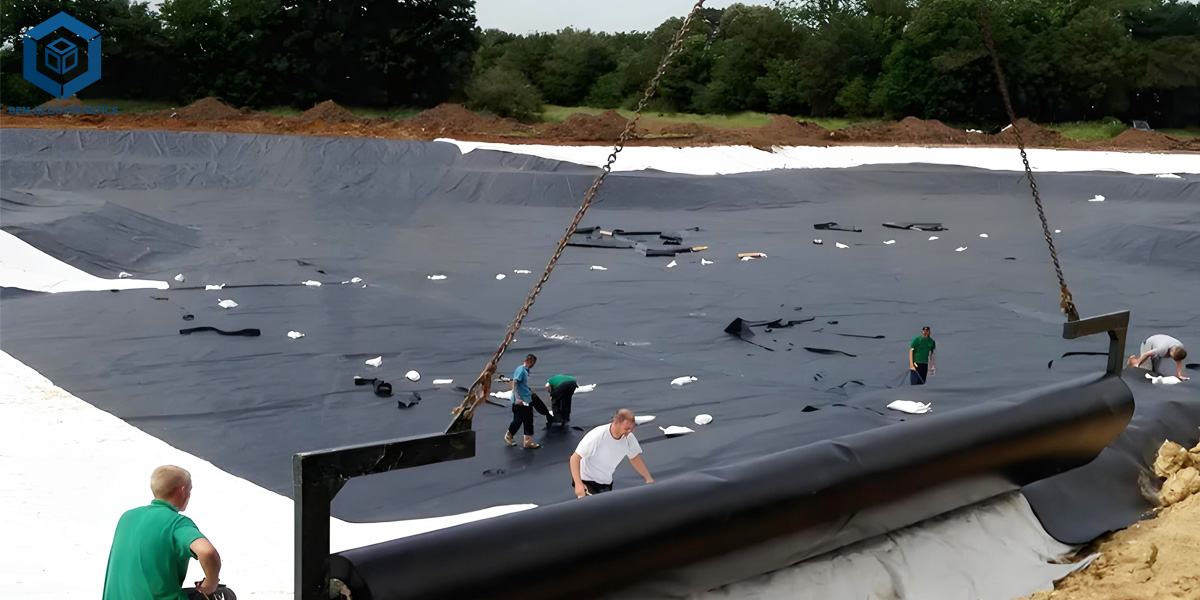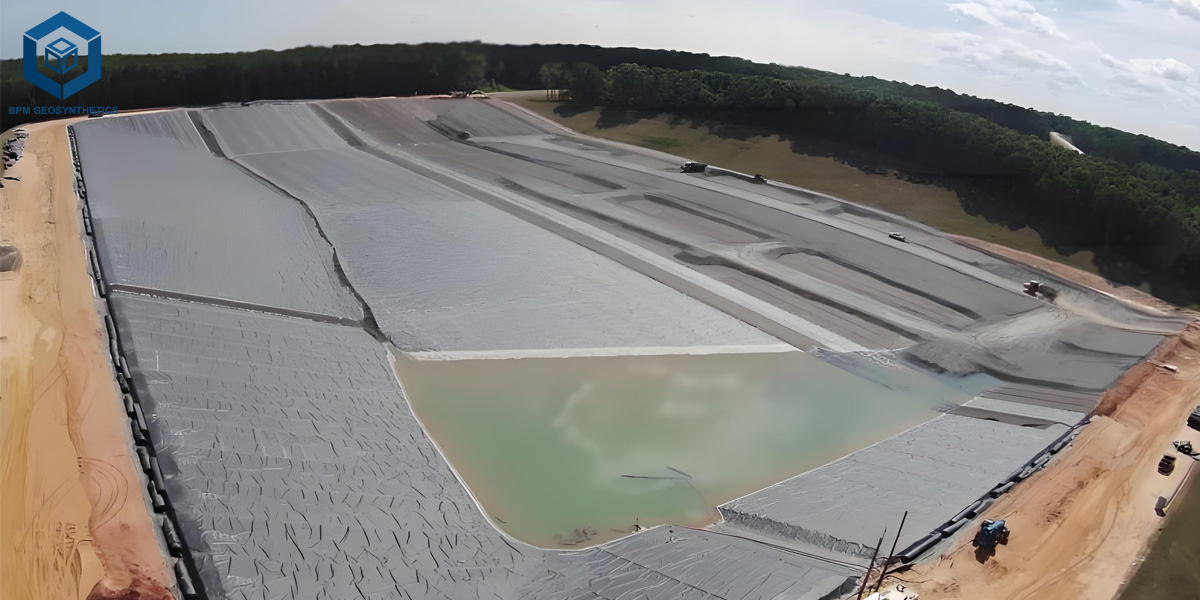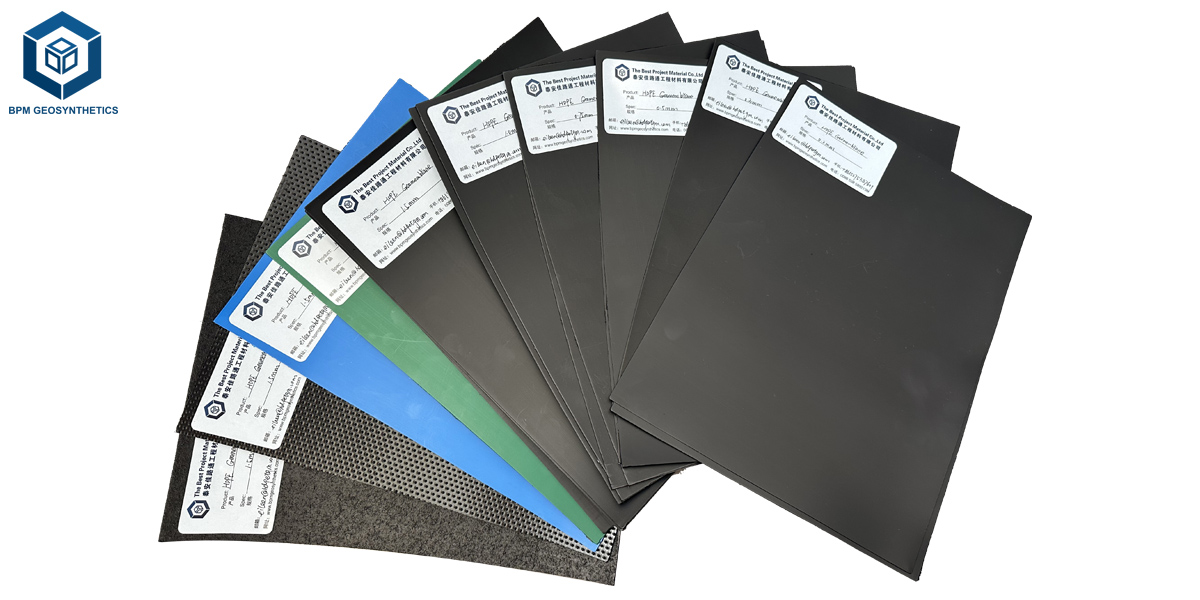What Are Advantages of Dam Liner Geomembrane?
Dam Liner Geomembrane has high tensile strength and wear resistance, which can effectively resist the impact and erosion of water flow and protect the dam surface and slope from being damaged. Dam Liner Geomembrane can also be used for the anti-seepage curtain project of the dam. In some special cases, the permeability of the bedrock or soil of the dam itself is high and cannot meet the anti-seepage requirements of the dam. At this time, Dam Liner can be used as an anti-seepage curtain material, embedded in the bedrock or soil, to prevent water penetration. BPM GEOSYNTHETICS is a leading manufacturer of HDPE geomembrane pond liner , known for its high-quality products and thoughtful services.
Today, Dam Liner Geomembrane made of high-density polyethylene (HDPE) is everywhere. In this article, we will analyze the advantages and disadvantages of Dam Liner Geomembrane.
1. What is Dam Liner Geomembrane?
Dam Liner Geomembrane is an essential anti seepage material in water conservancy projects. It has good impermeability and can replace clay core walls, anti-seepage inclined walls and prevent leakage in reservoir areas with its advantages of lightness, easy construction, low cost and reliable performance. HDPE Dam Liner is widely used in water conservancy projects and geotechnical engineering. Abroad, the application of Dam Liner Geomembrane has a history of more than 70 years, and large-scale application has only been in the past 20 years. Polyethylene plastic film was used in water conservancy channels for anti-seepage as early as possible, and later it was developed into special anti-seepage projects such as artificial lakes, environmental landfills, and tailings dams.
Dam Liner Geomembrane is a HDPE membrane material made of synthetic resins such as polyethylene, which is widely used in dam projects. It has excellent anti-seepage and anti-aging properties, can effectively prevent water penetration and leakage, and protect the safety and stability of the dam.
Dam Liner Geomembrane plays an important role in preventing seepage in dam projects. As an artificial water conservancy project, the dam needs to be able to effectively bear water pressure and hydraulic impact. If the bedrock or soil of the dam itself has a large permeability, it will cause water to penetrate into the dam body and damage the stability of the dam. Farm Dam Liners can be used as an anti-seepage layer to effectively prevent water penetration and ensure the safety of the dam.
1.1 Main Features of Dam Liner Geomembrane
- Dam Liner Geomembrane has an extremely low permeability and can effectively prevent the penetration of water, liquids or harmful substances. This feature is particularly important in water conservancy projects, environmental protection projects, and agriculture and fisheries. It can ensure the safety and stability of the project and prevent soil erosion and pollutant leakage.
- Dam Liner Geomembrane has high tensile strength and tear resistance, and can adapt to the needs of various harsh environments. In mine tailings ponds, roads, railway infrastructure and other projects, Plastic Dam Liners can withstand external pressure and mechanical friction, protect infrastructure from damage, and enhance the overall stability of the project.
- Dam Liner Geomembrane has strong corrosion resistance and chemical resistance, and can resist erosion and chemical reactions of chemicals in the soil, extending its service life. It has good weather resistance and can adapt to various climatic conditions, such as high temperature, low temperature, humidity, etc. Under long-term exposure to natural environments such as sunlight, wind, rain, and humidity, the geomembrane liner can still work stably and is not easy to age and damage.
2. What Are the Advantages of Dam Liner Geomembrane?
Dam liner geomembrane is a bendy and skinny anti-seepage cloth broadly used in hydraulic and environmental engineering. It affords various key blessings that make it perfect for long-term water containment applications:
2.1 Dam Liner Geomembrane - Excellent Impermeability
The geomembrane presents a continuous, dense, and uniform barrier to water infiltration. When correct designed and installed, it provides incredibly superb anti-seepage performance, minimizing water loss and defending surrounding soil structures.
2.2 Dam Liner Geomembrane - High Toughness and Flexibility
Dam liner geomembrane showcase wonderful mechanical power and elongation properties. They can adapt to a range of irregular or uneven surfaces and face up to doable contract or floor motion barring cracking or tearing. This makes them appropriate for complicated terrain and difficult website online conditions.
2.3 Dam Liner Geomembrane - Easy and Efficient Installation
Thanks to their light-weight nature, Smooth geomembrane is handy to transport, handle, and install. The foremost development method entails floor preparation, membrane laying, and joint welding or bonding, which is quickly and straightforward. This effectivity helps appreciably limit building time and labor costs.
2.4 Dam Liner Geomembrane - Excellent Chemical Resistance and Durability
Impermeable geomembrane liner is distinctly resistant to chemical assaults from soil, water, and industrial waste. They do no longer degrade effortlessly over time, even in harsh environments. This exceptional anti-corrosion overall performance ensures a lengthy carrier life, decreasing upkeep wishes and presenting big long-term financial benefits.
3. What Are the Disadvantages of Dam Liner Geomembrane?
While dam liner geomembrane provide severa blessings in water retention and environmental protection, there are additionally some conceivable drawbacks to reflect onconsideration on in the course of design, selection, and installation. Below are the predominant disadvantages:
3.1 Susceptible to Mechanical Damage
Due to its skinny and bendy polymer composition, the geomembrane is surprisingly inclined to bodily damage. It can be torn or punctured at some point of transportation, handling, or installation—especially if sharp objects like stones or particles are present. Excessive basis deformation, uneven settlement, or negative subgrade instruction can additionally lead to ruptures or stress factors that compromise the liner’s integrity.
3.2 Prone to Cracking in Low Temperatures
At low ambient temperatures, sure geomembrane substances may also emerge as brittle, growing the threat of cracking or stress failure. This problem can be addressed through the usage of cold-resistant geomembrane formulations (such as unique HDPE/LLDPE blends) or through improving the defensive layer above the membrane to buffer it from excessive temperature fluctuations.
3.3 Susceptibility to Aging and UV Degradation
When uncovered to direct sunlight, harsh climate conditions, or ozone over prolonged periods, geomembranes can steadily degrade due to oxidation and UV radiation. This growing old system outcomes in a loss of flexibility, strength, and impermeability. However, the charge of growing older is appreciably slower when the geomembrane sheet is buried or submerged, which is why protecting measures—like soil cover, ballast layers, or the usage of UV-stabilized materials—are often employed.
4. Is Dam Liner Geomembrane Really Effective?
Yes, dam liner geomembrane is a extraordinarily high-quality answer for anti-seepage in water conservancy projects. It is generally manufactured from high-density polyethylene (HDPE), a sturdy polymer fabric recognised for its first-rate mechanical strength, chemical resistance, and impermeability. During development and long-term operation, HDPE geomembrane demonstrates extremely good performance, specially in resisting tensile stress, accommodating floor deformation, and keeping long-lasting waterproofing.
Thanks to these extremely good properties, dam liner geomembrane has emerge as a favored desire in a number of hydraulic engineering purposes the place water containment and seepage manipulate are critical. Its effectiveness is now not solely evident in stopping water loss, however additionally in enhancing the structural integrity of reservoirs, dams, and canals.
In water conservancy projects, dam liner geomembrane performs a number of integral roles:
4.1 Dam Liner Geomembrane for Dam and Canal Seepage Control
By performing as a low-permeability barrier, the HDPE smooth geomembrane prevents or drastically reduces seepage via dam bodies, canal beds, and embankments. This helps keep steady water ranges and prevents structural erosion.
4.2 Dam Liner Geomembrane for Riverbank and Channel Protection
It serves as an erosion manage layer, defending banks and channels from being washed away through fast-moving water or seasonal floods. The geomembrane waterproofing enhances the sturdiness of protecting slopes and minimizes maintenance.
4.3 Dam Liner Geomembrane for Hydraulic Barrier on Dam Faces
Due to its near-zero permeability, geomembranes pond liner is regularly hooked up on the upstream face of dams, the place it varieties a non-stop water resistant layer. This barrier successfully blocks water infiltration into the dam structure, growing its sturdiness and safety.
In conclusion, Dam lining material has confirmed to be a dependable and long lasting answer for modern-day water administration infrastructure. Its huge adoption in international water conservancy initiatives underscores its cost in bettering venture performance, lowering environmental impact, and making sure long-term financial efficiency.
5. Summary
Dam liner geomembrane affords a vary of big advantages, together with notable anti-seepage performance, excellent bodily and chemical stability, ease of installation, environmental friendliness, and power efficiency. These traits make it a versatile and extensively used fabric throughout a variety of water conservancy and environmental engineering projects.
However, like any material, dam liner geomembrane additionally offers positive limitations. It requires well-prepared subgrade conditions, is prone to ultraviolet (UV) degradation when uncovered for lengthy periods, and may additionally contain fantastically excessive upfront costs. Therefore, when deciding on and making use of dam liner geomembranes, it is integral to consider each the blessings and the challenges primarily based on the precise wishes and stipulations of the project.
To make certain most effective overall performance and long-term reliability, it is surprisingly encouraged to select a relied on provider with demonstrated trip in the geosynthetics field. BPM Geosynthetics, as a main producer and exporter of geomembrane、geotextile、geocell、geogrid 、GCL and associated products, gives gorgeous dam liner options tailor-made to various engineering applications. With superior manufacturing technology, strict first-rate control, and expert technical support, BPM Geosynthetics is your dependable accomplice for fantastic and sustainable waterproofing systems.






